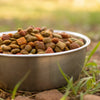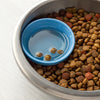Is Freeze-Dried Raw Dog Food as Good as Raw?
- Houndsy
Table of Contents
- Introduction
- What is Freeze-Dried Raw Dog Food?
- Nutritional Benefits of Freeze-Dried Raw Dog Food
- Comparing Freeze-Dried Raw and Traditional Raw Diets
- Potential Risks and Drawbacks of Freeze-Dried Raw Dog Food
- Practical Tips for Integrating Freeze-Dried Raw Dog Food into Your Pet's Diet
- Conclusion
Introduction
Did you know that the pet food industry has expanded so significantly that there are now over 100 different types of dog food available, from kibble to raw and everything in between? As dog parents, we often find ourselves overwhelmed with choices, each promising to deliver the best nutrition for our beloved companions. Among these options, freeze-dried raw dog food has emerged as a popular contender, raising an important question: is freeze-dried raw dog food as good as raw?
In this blog post, we will explore the intricacies of freeze-dried raw dog food, its benefits and drawbacks, and how it compares to traditional raw diets. Understanding these nuances is crucial for enhancing our dogs' health and well-being while simplifying our feeding routines. By the end of this post, you will have a clearer picture of how freeze-dried raw dog food fits into the broader landscape of canine nutrition, helping you make an informed decision for your four-legged friend.
We will delve into the following aspects:
- What freeze-dried raw dog food is and how it's made.
- Nutritional benefits of freeze-dried raw dog food.
- Comparisons between freeze-dried and traditional raw diets.
- Potential risks and drawbacks associated with freeze-dried foods.
- Practical tips for integrating freeze-dried raw dog food into your pet's diet.
So, let’s take a closer look at this intriguing topic and see how we can elevate our dog's feeding experience.
What is Freeze-Dried Raw Dog Food?
Freeze-dried raw dog food is a type of pet food that retains the nutritional benefits of raw ingredients while being shelf-stable and easy to serve. The freeze-drying process involves freezing the raw ingredients and then using a vacuum to remove moisture through sublimation—turning solid ice directly into vapor without passing through the liquid phase. This method effectively preserves the food's nutrients, taste, and texture, making it a convenient option for pet owners.
Ingredients Typically Found in Freeze-Dried Raw Dog Food:
- High-quality raw meats (like chicken, beef, or lamb)
- Organs (such as liver)
- Fruits and vegetables (for added vitamins and minerals)
- Natural preservatives (like tocopherols)
- Probiotics and prebiotic fibers (to support digestion)
This unique preparation method allows us to provide dogs with a minimally processed, nutrient-dense diet without the need for refrigeration, making it a practical choice for busy pet owners.
Nutritional Benefits of Freeze-Dried Raw Dog Food
When we feed our dogs freeze-dried raw food, we are offering them a diet that closely resembles what they would naturally consume in the wild. Here are some of the nutritional benefits associated with freeze-dried raw dog food:
- Retention of Nutrients: The freeze-drying process preserves essential vitamins, minerals, and enzymes that can be lost during traditional cooking methods. This ensures that our pets receive a nutrient-rich diet.
- High-Quality Protein: Freeze-dried raw dog food is typically high in animal protein, which is crucial for building and maintaining muscle mass, supporting energy levels, and overall health.
- Enhanced Digestion: The natural enzymes present in raw ingredients can aid in digestion, making it easier for dogs to absorb nutrients effectively.
- All-Natural Ingredients: Many freeze-dried brands focus on using whole food ingredients without fillers, artificial additives, or by-products, appealing to health-conscious pet owners.
- Convenience: Freeze-dried food is lightweight and has a long shelf life, making it easy to store, transport, and serve. This aspect is particularly beneficial for those who travel with their dogs or have limited kitchen space.
By providing our dogs with freeze-dried raw food, we can offer them a meal that is not only nutritious but also convenient for our busy lifestyles.
Comparing Freeze-Dried Raw and Traditional Raw Diets
Understanding the distinctions between freeze-dried raw dog food and traditional raw diets is essential for making an informed choice. While both options offer similar nutritional benefits, they come with different considerations.
Nutritional Content
Both freeze-dried and traditional raw diets can be high in protein and rich in essential nutrients. However, freeze-dried foods may contain additional ingredients, such as fruits and vegetables, that enhance the overall nutritional profile. Traditional raw diets often focus on raw meats and bones, which can provide high-quality protein but may lack some of the vitamins and minerals found in freeze-dried options.
Convenience and Storage
As mentioned earlier, freeze-dried raw dog food offers incredible convenience. It requires no refrigeration and is easy to serve—simply add water to rehydrate. In contrast, traditional raw diets must be kept frozen and require thawing before serving, which can be less convenient for busy pet owners.
Safety Concerns
Both freeze-dried and traditional raw diets pose some safety risks primarily associated with pathogen exposure. While freeze-drying reduces moisture and helps inhibit bacterial growth, it does not eliminate all pathogens. Proper handling and hygiene practices are essential to minimize risks for both humans and pets.
Cost Considerations
Freeze-dried raw dog food can be more expensive than traditional raw diets due to the complex freeze-drying process. However, the convenience and extended shelf life may justify the cost for many pet owners. Traditional raw diets can be more budget-friendly, especially if prepared at home, but they require careful planning and preparation.
Ultimately, the choice between freeze-dried and traditional raw diets will depend on our dog's specific needs and our individual lifestyles.
Potential Risks and Drawbacks of Freeze-Dried Raw Dog Food
While freeze-dried raw dog food offers many benefits, it is essential to be aware of the potential risks and drawbacks:
- Pathogen Exposure: As mentioned earlier, freeze-drying does not eliminate all pathogens, which can be a concern for both dogs and humans. It's crucial to handle the food safely and maintain proper hygiene practices.
- Incomplete Nutrition: Not all freeze-dried dog foods are formulated to meet the Association of American Feed Control Officials (AAFCO) standards for complete and balanced nutrition. It is vital to choose products that are AAFCO-approved to ensure our pets receive adequate nutrition.
- Cost: Freeze-dried dog food is often more expensive than traditional kibble or even some raw options. Pet owners should consider their budget when choosing a feeding option.
- Rehydration Needs: While freeze-dried food can be convenient, it requires rehydration before serving. Some dogs may not enjoy the texture of rehydrated food as much as fresh raw or kibble.
- Limited Variety: Many freeze-dried brands offer a limited selection of protein sources compared to traditional raw diets, which may make it challenging to rotate proteins for dogs with allergies or sensitivities.
Being aware of these considerations allows us to make more informed decisions when selecting the best feeding option for our furry companions.
Practical Tips for Integrating Freeze-Dried Raw Dog Food into Your Pet's Diet
If you're considering transitioning your dog to freeze-dried raw food, here are some tips to ensure a smooth and successful experience:
- Gradual Transition: When introducing a new diet, it's crucial to do so gradually. Start by mixing a small amount of freeze-dried raw food with your dog's current diet, gradually increasing the proportion over several days to minimize digestive upset.
- Hydrate Properly: Follow the manufacturer's instructions for rehydrating the food. Generally, a ratio of one part freeze-dried food to two parts water works well. Allow it to sit for a few minutes to ensure thorough rehydration.
- Monitor Your Dog's Health: Keep an eye on your dog's response to the new diet, including their energy levels, coat condition, and overall health. If you notice any adverse reactions, consult your veterinarian.
- Rotate Proteins: To prevent food sensitivities and provide a well-rounded diet, consider rotating different protein sources. If your chosen freeze-dried brand offers various flavors, try incorporating them into your dog's feeding routine.
- Storage: Store freeze-dried food in a cool, dry place and keep it sealed to maintain freshness. Unlike traditional raw diets, freeze-dried food does not require refrigeration, making it easy to keep on hand.
By following these practical tips, we can ensure that our pets enjoy the benefits of freeze-dried raw dog food in a safe and enjoyable manner.
Conclusion
Navigating the world of dog food options can be overwhelming, but understanding the differences between freeze-dried raw dog food and traditional raw diets can empower us to make the best choices for our furry friends. Freeze-dried raw food offers a convenient, nutrient-rich alternative that retains the benefits of raw feeding while eliminating some of the complexities associated with traditional raw diets.
As we continue to prioritize our dogs' health and well-being, let us consider the advantages and potential drawbacks of each feeding option. Ultimately, the best choice will depend on our dog's specific needs, our lifestyle, and our personal preferences as pet parents.
If you're looking to simplify your dog's feeding routine while providing the highest quality nutrition, consider exploring the Houndsy Kibble Dispenser. This innovative product ensures perfect portion control and eliminates the mess often associated with dog feeding, allowing us to enjoy mealtime with our pets.
Frequently Asked Questions (FAQs)
1. Is freeze-dried raw dog food safe for all dogs? While freeze-dried raw dog food can be a safe and nutritious option for many dogs, it is essential to consult with your veterinarian, especially if your dog has specific health concerns or dietary restrictions.
2. How should I store freeze-dried raw dog food? Freeze-dried dog food should be stored in a cool, dry place and kept sealed to maintain freshness. Unlike traditional raw diets, freeze-dried food does not require refrigeration.
3. Can I mix freeze-dried raw dog food with kibble? Yes, many pet owners choose to mix freeze-dried raw food with kibble to provide a balanced diet. Just ensure that the total diet meets your dog's nutritional needs.
4. How do I transition my dog to freeze-dried raw food? Introduce freeze-dried raw food gradually by mixing it with your dog's current food and slowly increasing the ratio over several days to avoid digestive upset.
5. Are there any health benefits to feeding my dog freeze-dried raw food? Freeze-dried raw food retains essential nutrients and enzymes that support digestion and overall health. It closely mimics a dog's natural diet, providing a range of nutritional benefits.
If you're ready to elevate your dog's feeding experience, check out the Houndsy Kibble Dispenser and discover how we can simplify mealtime for you and your furry companion!












